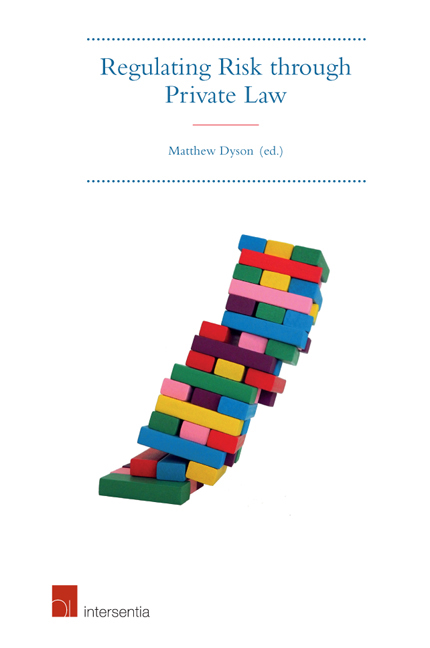Book contents
- Frontmatter
- Preface
- Contents
- Table of Cases
- List of Contributors
- Chapter 1 Introduction
- Part I Risk Overviews
- Chapter 2 Risk and english tort law
- Chapter 3 Risk and French Private Law
- Chapter 4 Risk in Swedish Tort Law: Of Models and Muddles
- Chapter 5 Risk and Italian Private Law
- Chapter 6 Regulating Risk Through Private Law: The Spanish Approach
- Chapter 7 How Dutch Tort Law Responds to Risks
- Chapter 8 Risk and Chilean Private Law
- Chapter 9 Regulating Risk Through Private Law: South Africa
- Chapter 10 Risk and Brazilian Private Law
- Part II State of the national art on risk
- Index
- About the Editor
Chapter 5 - Risk and Italian Private Law
from Part I - Risk Overviews
Published online by Cambridge University Press: 13 October 2018
- Frontmatter
- Preface
- Contents
- Table of Cases
- List of Contributors
- Chapter 1 Introduction
- Part I Risk Overviews
- Chapter 2 Risk and english tort law
- Chapter 3 Risk and French Private Law
- Chapter 4 Risk in Swedish Tort Law: Of Models and Muddles
- Chapter 5 Risk and Italian Private Law
- Chapter 6 Regulating Risk Through Private Law: The Spanish Approach
- Chapter 7 How Dutch Tort Law Responds to Risks
- Chapter 8 Risk and Chilean Private Law
- Chapter 9 Regulating Risk Through Private Law: South Africa
- Chapter 10 Risk and Brazilian Private Law
- Part II State of the national art on risk
- Index
- About the Editor
Summary
The Italian Civil Code (c.c.), the main source of law for extracontractual liability (for present purposes, equivalent to ‘tort’), does not specify risk-taking or -producing as a source of extracontractual liability. On the other hand, risk has long been well known to specialists of contract law, as it was the main component of ‘aleatory contracts’, that is, contracts that have as their main goal to shift risk from one party to another. We can therefore find in Italian contract law detailed provisions on risk shifting and disclosure of information from the insured party to the insurer (arts. 1882 – 1914 c.c.), and some provisions about the aleatory contract of sale (art. 1472, paragraph 2). After World War II, the thinking about risk has extended to extracontractual liability. This has been driven primarily by scholars and judges, building risk into the Civil Code provisions on extracontractual liability. The result is that ‘liability for risk’ is now well established in its substance in Italian law. The result is not a clear-cut category of ‘risk’, but nonetheless legal actors are able to reason in respect of ‘risk’, and not only of fault, when ascribing liability.
This chapter is divided into two sections. In the first, we will show how the concept of risk entered into the field in extracontractual liability through two main devices: negligence and liability for dangerous activities. In the second section, we will address more specific liability for dangerous activities, questions related to civil procedure and liability for endangerment.
RISK IN THE EXTRACONTRACTUAL DOMAIN
The Italian Civil Code was enacted in 1942; it shows strong French roots, but the drafters of the Code took a substantively new approach on issues regarding extracontractual liability. This was in part because the industrial revolution was only just beginning in Italy, but also because they sought to incorporate developments from decades of case law. The result for extracontractual liability was one very basic article – article 2043 – that illustrates the conditions for establishing liability, coupled with original and specific articles on special liabilities.
Article 2043, which sets out the basis of tort liability, reads:
‘Q ualunque atto doloso o colposo che causa ad altri un danno ingiusto obbliga colui che ha commesso il fatto a risarcire il danno’.
- Type
- Chapter
- Information
- Regulating Risk through Private Law , pp. 113 - 138Publisher: IntersentiaPrint publication year: 2018

